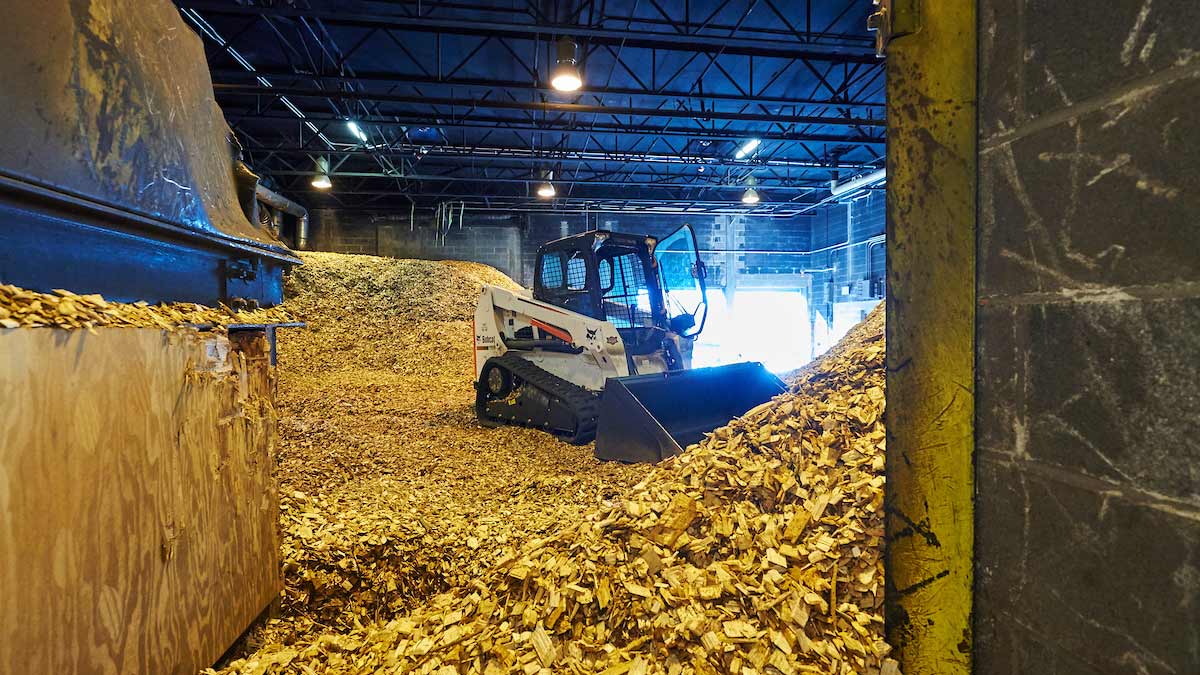



Climate change is one of the defining issues of our time. Fortunately, Colgate University accepts responsibility for its contribution to global climate change and is taking action to mitigate the impacts while preparing to thrive in a low-carbon future. By achieving carbon neutrality in 2019, Colgate will be the first college or university in New York State to achieve this goal and one of only a few institutions to achieve carbon neutrality nationwide.
What is a carbon footprint?
A carbon footprint is the amount of carbon and/or greenhouse gases emitted directly or indirectly by an entity such as Colgate. Each member of the Colgate community has their own individual carbon footprint associated with things like travel, home energy use, purchasing, and food. You can calculate your personal carbon footprint here. Colgate University also has a carbon footprint, encompassing emissions from transportation, energy use for heating and cooling, electricity, waste, fertilizer use, and paper consumption. Many of these emissions are associated with the use of fossil fuels. These greenhouse gas emissions from our campus and our personal lives contribute to global climate change.
What is the difference between gross campus emissions and net campus emissions?
Gross emissions are the total emissions produced through Colgate's buildings and business functions. Net emissions represent campus emissions minus any investments the university makes in carbon offsets.
What is Colgate’s carbon footprint?
In Fiscal Year 2017, Colgate emitted 13,233 metric tons of carbon dioxide equivalent (MTeCO2). Since 2009, we have reduced our net campus carbon footprint by 8,632 MTeCO2, representing a 51 percent reduction. See Colgate’s 2017 State of Sustainability Report for more information.
What does it mean to be carbon neutral?
To be carbon neutral is to have zero net emissions. This means offsetting whatever emissions Colgate cannot, or will not, reduce through on-campus projects, policy changes, or changes in behavior. As a result, achieving carbon neutrality by 2019 and beyond requires reducing greenhouse gas emissions on campus and investing in high-quality carbon offset projects that counterbalance Colgate's remaining emissions.

A tractor collects renewably-harvested wood chips used to fuel Colgate's wood-burning boiler.

What has Colgate already done to reduce its carbon footprint?
Colgate has reduced its gross carbon emissions by 21 percent since 2009. This is a result of green building practices during renovations and new construction, energy efficiency projects such as lighting and HVAC systems upgrades, renewable energy projects like a wood boiler upgrade, installation of a geothermal heat exchange system at Chapel House, and a solar thermal array installed at 100 Broad Street. Peer-to-peer education programs have also helped to change behavior across campus and reduce emissions.
Why do we need to invest in offsets to be carbon neutral? Why can’t we just eliminate all of our on-campus and business-related emissions?
Significant sources of Colgate’s emissions from business-related air travel, faculty and staff commuting, campus vehicles, and some forms of energy use are currently impossible to eliminate without extraordinary cost or disruption to our academic mission. Since Colgate cannot eliminate all on-campus emissions by 2019, investing in offsets to achieve carbon neutrality is necessary. For example, over 40 percent (6,147 MTeCO2) of Colgate’s gross emissions comes from commuting and business travel. Travel is essential for faculty research, admission, institutional advancement, service learning, and athletics. So, to compliment emission reduction strategies on campus, Colgate has resolved to invest in carbon offsets for the foreseeable future.
What are carbon offsets?
Carbon offsets are investments in off-campus projects that reduce, remove, or avoid greenhouse gas (MTeCO2) emissions. Offsets serve as a counterbalance to emissions from on-campus activities. Carbon offset projects come in many forms but generally fall into two broad categories: 1) projects that reduce or avoid emissions, such as the installation of a wind park or solar farm to replace a coal-fired energy plant, and 2) projects that sequester or remove greenhouse gases from the atmosphere, such as planting trees that absorb atmospheric carbon as they grow. Investing in high-quality certified offsets is widely regarded as an effective way to combat climate change for organizations who accept responsibility for their carbon footprints and are looking to mitigate the emissions they cannot eliminate through their operational practices.
Does Colgate currently invest in any offset projects?
Yes. Since 2012, Colgate has been investing in a reforestation project in Patagonia, Chile. As the trees grow and the native forest is restored, carbon is removed (sequestered) from the atmosphere. Colgate’s financial investment in the project allows Colgate to take credit for the carbon removed from the atmosphere under the Verified Carbon Standard protocol. Learn more about the Patagonia reforestation project here.


Do carbon offsets actually make a difference when it comes to climate change?
Yes, in fact, carbon offsets are a very useful climate change mitigation tool. By investing in carbon offsets, an organization invests in something that will mitigate the social and environmental impacts of climate change. Carbon offset projects and programs also go through a verification process. Many times, offsets are validated and verified through a third party like the Verified Carbon Standard or the American Carbon Registry. There is also an emerging peer review model highlighted in Second Nature’s 2016 Carbon Market’s and Offset Guidance report that can be used to verify some carbon offset projects. While implementing on-campus projects that reduce Colgate's greenhouse gas emissions remains the top priority, the university must also choose among a myriad of carbon offsets options to achieve its institutional goal of carbon neutrality by 2019 and beyond.
Why is Colgate’s Carbon Neutrality date so soon? Why not wait?
As outlined in our 2011 Climate Action Plan, Colgate decided to respond to the ongoing and increasing threat of climate change with a sense of urgency by setting a 2019 Carbon Neutrality date. As a result, Colgate University is one of a handful of top-tier institutions committed to reducing its campus carbon footprint while also taking accountability for its remaining footprint by investing in carbon offsets. Our institution recognized that climate change is happening now and agreed that we need to take responsibility for our emissions sooner rather than later. Investing in offsets creates a strong financial incentive to reduce on-campus emissions that would obviate the need to purchase future offsets on an annual and ongoing basis. It also creates an opportunity for education and innovation.
Why is it important for Colgate to achieve carbon neutrality?
The Thirteen Goals of a Colgate Education reflect the values of our institution and principles of sustainability are a key theme throughout. Being a model for climate action in our operations and in our pedagogy supports the core institutional values of Colgate University. Colgate can uphold its value of social justice and environmental stewardship by addressing climate change with a sense of urgency.
What happens after 2019?
We will be carbon neutral in 2019, but that doesn't mean our work is done. In a sense, it’s just the beginning since 2019 marks year 1 of a recurring annual commitment. In the years ahead, Colgate will continue to focus on reducing our gross campus emissions through the new Green Revolving Loan Fund, student programs, and continued employee education. We will make community resilience and climate preparedness a top priority and continue to build a culture of environmental and social responsibility at Colgate.
Visit colgate.edu/carbon for more information about Colgate’s commitment to carbon neutrality. Learn more about the carbon offset options we are reviewing here.
